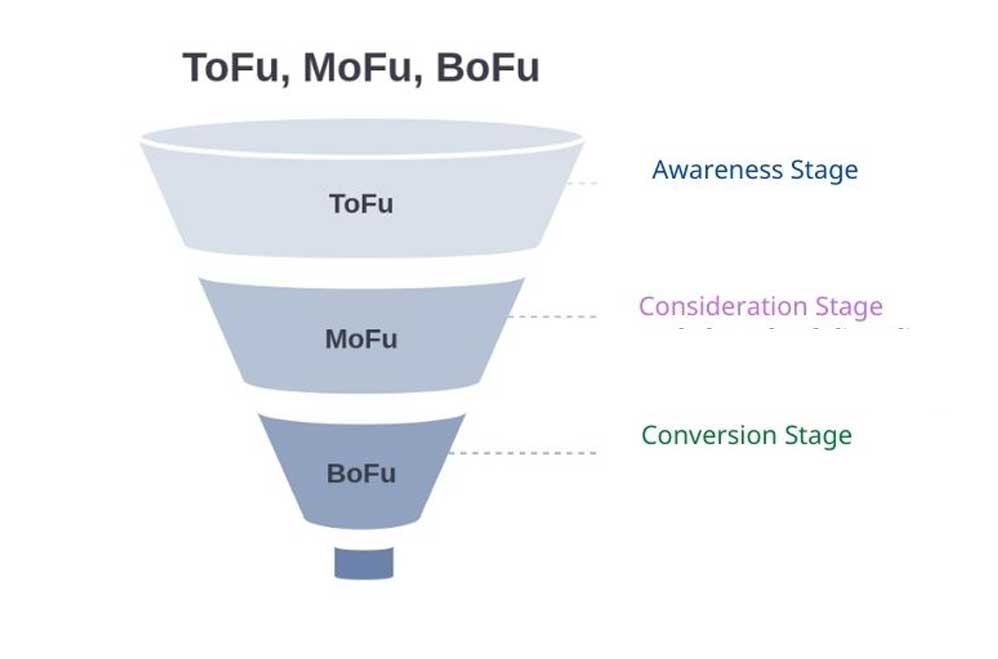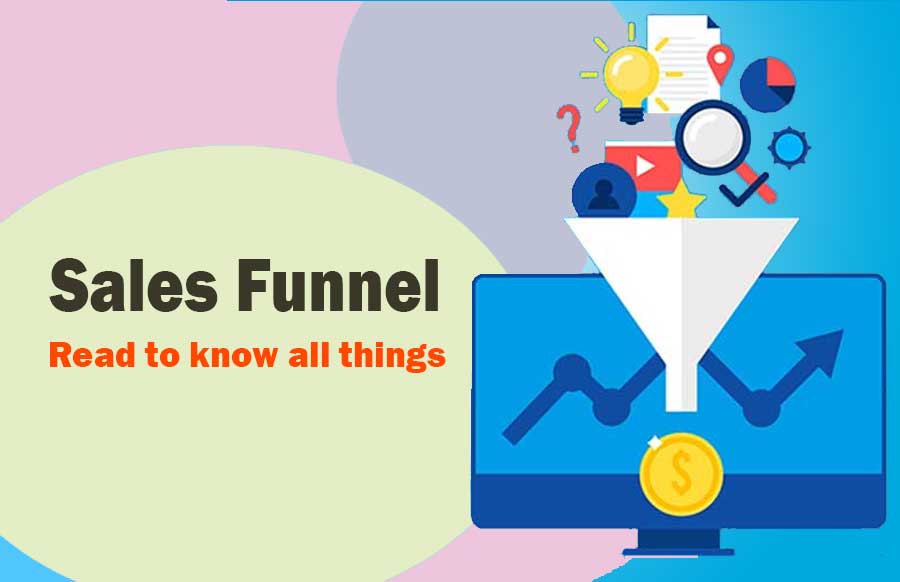What is Sales Funnel in Marketing – Strategy Building, Stages & more details given in this article – If you want to get better ROI using Digital Marketing , then for this you have to use Sales Funnel, if you want to know what is Sales Funnel? And how to make it then this blog post is just for you.
Marketing is very easy in today’s digital world, yes here too one has to face the competition but in today’s date there are many tools and techniques by which we make our customers, one of them is the technique also known as Sales Funnel. goes.
In today’s time without a sales funnel, you cannot know about your customers what they want. Sales Funnel proves to be very helpful in keeping information about your customer’s interest, their online shopping behavior and their buying decision.
What is Sales Funnel in Marketing Information?
When a customer buys a company’s product or service , the stage he passes through to buy it is called the sales funnel . The sales funnel has several stages, commonly known as the awareness stage, interest stage, and decision stage , although these stages can vary depending on the company’s sales model.
Any business owner knows the pain of simply not having it. If you haven’t used a sales funnel, then after weeks of pitches and demos, chatter and hype, chances are no one will buy your product or service, but this is rarely the case when you have the right sales funnel .
There are 4 basic stages of Sales Funnel by which we know about our customer.
- Awareness
- Interest
- Decision
- Action

Read here about more for Sales Funnel on Wiki
Importance of Sales Funnel
Sales Funnel helps you understand what potential customers are thinking and doing at each stage of the buying journey. These insights help you invest in the right marketing activities and channels, create the most relevant messages during each stage, bring in leads and convert more potential customers into paying customers.
Sales funnel stages
From the moment potential customers hear about your product or service until they make a purchase (or not), they go through different stages of your sales funnel. That journey through your Sales Funnel may turn from one possibility to another, but in the end, the customer decides to buy according to their interest. They will think about the problem they are trying to solve.
In general, there are 3 main steps:
Step 1: Awareness
The first stage of the sales funnel is called the “ awareness ” level, because this is where people first become aware of your product or service. They can hear about you from your ads, social media, even from tongues.
How and why those people go down the sales funnel depends on your own sales and marketing ability.
Best Content Types for this Step: Articles, Blog Posts, E-Books, Videos, Newsletters
An example of an awareness phase would be the possibility of learning about your company for the first time. They may have clicked on one of your ads, read your blog, found your website through a Google search , or heard a colleague talk about your product or service.
Step 2: Interest
Once prospects know about your brand, they will evaluate it based on their level of interest. They will think about the problem they are trying to solve.
Best Content Types for This Step: Case Studies, How-to Articles, How-to Videos, Checklists/Worksheets
In this stage, you have to get them interested in your product or service by solving their problems so that they stay at the top of the funnel.
Step 3: Decision – Conversion
Now with information about your company, prospects will learn more about your pricing and packaging options. Sales pages, webinars and calls are helpful in this phase, helping to influence prospects to make a purchase.
Best Content Types for This Step: Case Studies, User-Generated Content, Buyer’s Guide, Product Videos, Research Reports, Webinars
All your work comes down to this stage: This is the stage where your customers make their buying decisions, but they may not take it, so you will have to retarget them.
Read also: How To Promote Affiliate Links – 7 Best Tips
How to create a sales funnel for your business?
For your sales funnel to exist, you first need potential customers who can move through that funnel. Once you have those prospects, you can track behavior and engagement using lead scoring to identify where they are in the funnel.
Here are five steps to help you build a sales funnel :
1. Build a Landing Page
A landing page is most likely the first time potential customers learn about your company. If they click on an ad, sign up for a webinar , or download an eBook , they’ll be taken to a landing page . That page should clearly state who you are as a company and your unique benefits (after all, this may be the only opportunity you have to wow prospects). And, most importantly, make sure the landing page has a form for potential customers to enter their information – you want to capture their email address so you can continue to communicate with them.
2. Offer Something of Value
Here is the part where you have to give something to a potential customer in exchange for their email address. Lead magnets , ebooks or white paper are an effective way to deliver something of value to your landing page.
3. Start Nurturing
At this point, the potential customer will move from the awareness phase to the interest phase. And, since you have all their email addresses from the landing page, you can create an email nurturing chain to share educational material about your offering.
4. Upsell
As potential customers move into the decision phase, you want to offer anything that can steer them towards the purchase decision. This may include product demos, extended free trials or special discounts.
In the action phase, you will either acquire new customers or hear why customers are not interested in purchasing . Either way, keep the communication going. For new customers, focus on product information, engagement and retention . For potential customers who didn’t buy, create a new nurturing chain to check with them every few months.
Read Also: Top 10 Digital Marketing Agency City Wise List
Find the Errors in Your Sales Funnel Steps
Now that you know how to build a sales funnel , let’s begin to look at why sales funnel management matters. Even the very best potential customers can fall out of the sales funnel if they are not nurtured carefully. The best way to prevent that loss is to have a clear idea of the steps in your sales process—and help carry those steps .
In some companies, those sales stages might look something like this:
Image of a sales funnel missing leads
Marketing helps you to bring potential customers to the first stage of your sales funnel . Note that wherever possible the phases are divided into two or more phases. A demo can be called single stage , but in real life it involves a lot of things: contacting the customer, sending reminders, doing the demo and then following up. Whatever your own sales funnel steps, you’ll have the support you need to manage them.
Once you know your sales funnel steps, it’s time to figure out where you’re losing potential customers. Sit down with your team (or with yourself, if you’re the CEO, CMO, and head janitor) and ask yourself:
- Where are the bottlenecks in my sales process ?
- Where is my mistake of losing track of potential customers ?
- What are positive trigger points—specific actions that typically result in sales?
Look carefully for cracks where your chosen steps are not working. Then get ready to fix your funnel.
Sales funnel metrics
Companies use various metrics to analyze and score leads and potential customers during the sales funnel to evaluate the success of their sales teams.
Examples of lead-to-revenue management metrics include the following:
Average order value: This shows the average amount of revenue generated from each order or purchase. This is important because it shows how valuable the average individual customer is.
Customer lifetime value: This determines the value of each sales opportunity in the funnel.
Conversion rate: This is the percentage of leads that are converted into customers.
Entrances: This is the number of leads that enter the funnel during a specific period of time.
Follow-ups: This is the number of potential customers that have to be re-contacted by the business’s initial marketing efforts.
Flow rate: The optimum flow rate is the average amount of time at each stage of the funnel.
Total revenue: It is the total amount of revenue generated from all sales in a given period.
Win rate: This is the percentage of deal closings divided by the total number of deals in the pipeline.
Software to Build Sales Funnel
If you want, you can use any software to make Sales Funnel. So that a good and attractive Sales Funnel can be created and sales of your product or service increase and set a new record.
Below we have told about some such software. From where you can very easily create your sales funnel –
- Instapage
- Leadpages
- builderall
- Kajabi
- ClickFunnels
- GetResponse
- Kartra
My Final Word:
We hope that after reading this blog post your question is What is Sales Funnel? How to make (Sales Funnel in Marketing Information in Hindi)? You will get the answer easily.

